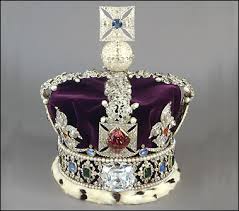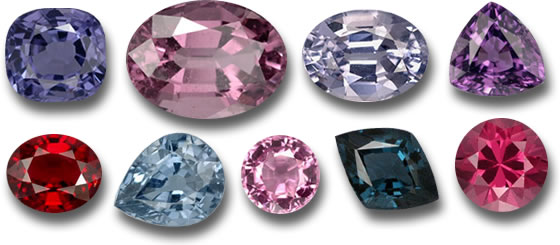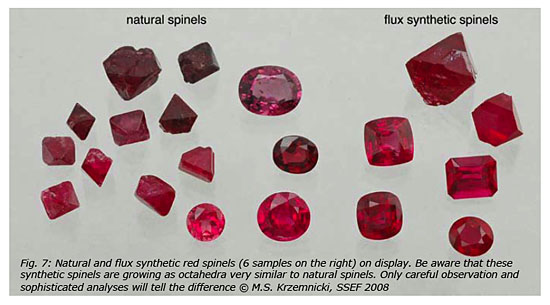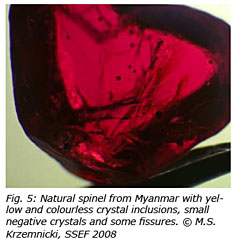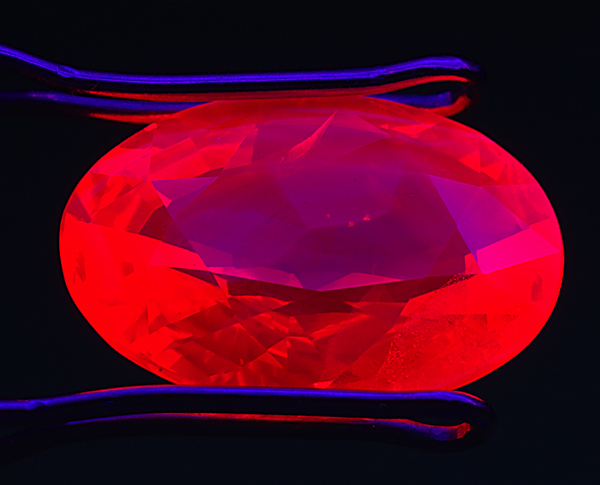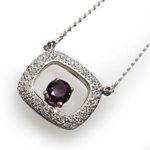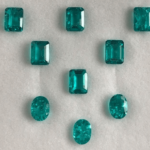How-to-separate-synthetic-and-natural-spinels
Natural Spinels: Originally, Spinels and Rubies were considered as the same stone because Natural Spinels were found in the same locations as Corundum. The red color species of Spinel were misidentified as Ruby and other colors of Spinels were as Sapphires. Even for centuries, the magnificent red gemstone of 5.08 centimeter popularly known as “Black Prince Ruby” at the center of the British Imperial Crown was thought to be Ruby only but studies have recently shown that the stone is Spinel actually.
British Imperial Crown, Picture Courtesy- Wiki Pictures
The most fascinating features of Spinels are:
- They are singly refractive. Gemstones other than Diamonds, Spinels, and Garnets are double-refractive.
- There is a complete absence of cleavage.
- They formed as a cubic crystal like a Diamond.
- Spinel is seen in a wide range of colors: red, lavender, violet, blue, green, brown, black, and grey.
- Spinels have long Toughness & Durability.
View this post on Instagram
In case you would like to discuss anything about spinels and wholesale spinels, do not hesitate to send an email directly to Navneet our marketing head at navneet@navneetgems.com.
Spinel- Gemological Properties
| Chemical composition | Mg(Al2O4) Magnesium aluminum oxide |
| Crystal system | Cubic |
| Habit | Octahedral, contact twins |
| Cleavage | Imperfect |
| Fracture | Conchoidal, uneven |
| Hardness | 8 |
| Optic nature | Isotropic |
| Refractive index | 1.712 – 1.736 |
| Birefringence | None |
| Dispersion | 0.026 |
| Specific gravity | 3.58 – 3.61 |
| Lustre | Vitreous |
| Pleochroism | None |
The most significant deposits of Spinels occurred in Myanmar (Burma), Sri-Lanka (Ceylon), Cambodia, Thailand, Brazil, Madagascar, Nepal, Tanzania, Tadzhikistan, Afghanistan, and Australia. Spinels come in a variety of colors which range from blue spinel, red spinel, green spinel, yellow spinel, brown spinel, black spinel, orange spinel, pink spinel to violet spinel. But the rarest Spinel is Cobalt Blue Spinel which has a rich deep blue color.
Here, You can also check out :SPINELS: HISTORIC UNDERDOGS, MODERN DAY MARVELS.
Central Asia Corundum and Spinel Reserves, Picture Courtesy- Ruby Sapphire.com
Types of Spinels: A variety of names has been given to the different members of the Spinel family. Some are:
- Balas Spinel: These are a pale-red variety of Spinel is called Balas Spinel. In the past, it was mistakenly known as Balas Rubies.
- Flame Spinel: These are bright orange and orange-red varieties of Spinel. In the past, it was known as Rubicelle.
- Hercynite Spinel: The color of Hercynite ranges from dark-green to black, due to the presence of iron content.
- Pleonaste Spinel: The color of Pleonaste is also dark-green to blackish opaque, but is a little lighter than Hercynite. It is popularly known as Ceylonite.
- Gahnite Spinel: These are blue, violet, and dark-green to black varieties of Spinel. Sometimes also known as Zinc Spinel.
- Gano Spinel: The color of this variety is similar to Gahnite but less dense colors are found.
- Picotte Spinel: These are yellowish-brown, dark-green to black variety of Spinel. Sometimes known as Chrome Spinel.
Synthetic Spinels: Spinels can be synthesized by using three methods:-
- Verneuil (flame-fusion) method
- The flux-melt method
- Czochralski (pulling) method.
View this post on Instagram
|
Properties of Flame Fusion Synthetic Spinel |
||||
|
Color |
Coloring agent(s) |
RI |
SG |
Other diagnostic tests |
| Colorless | none | 1.728–1.740 | 3.65–3.80 | LW UV: green; SW UV: white/blue |
| Red | Cr3+ | 1.722–1.725* | 3.58–3.60 | curved striae; spectrum; fluorescence |
| Pink | Cu | 1.727–1.740 | 3.65–3.80 | |
| Yellow | Mn | does. | do. | LW/SW UV: green |
| Emerald green | Mn + Co3+ | do. | do. | |
| Tourmaline green | Cr3+ | do. | do. | spectrum |
| Beryl green | Cr3+ + Mn | do. | do. | spectrum |
| Zircon blue | Co3+ + Cr3+ + Ti | do. | do. | spectrum |
| Sapphire blue | Co3+ | do. | do. | spectrum; fluorescence; CCF |
| Amethyst violet | Co3+ + Mn | do. | do. | |
| Alexandrite color change | Cr3+ + V | do. | do. | spectrum |
| Lapis lazuli imitation | Co3+ | 1.725 | 3.52 | spectrum; C |
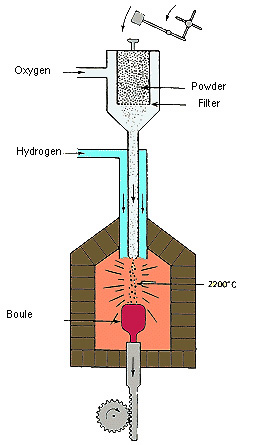
The Flux-Melt Method: It was observed that by the Flame-Fusion method red spinels of larger quantity cannot be produced. To produce, bigger red even the blue Spinels the Flux-Melt method is used. The synthetics produced by this method are true synthetics as they are produced by a 1:1 ratio of alumina and magnesium.
|
Properties of Flux-Melt Synthetic Spinel |
||||
|
Color |
Coloring agent(s) |
RI |
SG |
Other diagnostic tests |
| Red | Cr3+ | 1.716-1.719 | 3.58-3.62 | LW/SWUV: distinct red-orange/red residual flux inclusions |
| Blue | Co2+ + Fe2+ | 1.719 | 3.58 | Spectrum; SWUV: inert; LWUV: Weak red residual flux inclusions |
The Czochralski (pulling) Method: This method is a recent development (2007). The production of red to pink Synthetic Spinels is done by Czochralski (pulling) method.
Difference between Natural and Synthetic Spinels:-
Picture Courtesy – GIA
1. Microscopic Evidence: Synthetic Spinels have flux or some growth viewed under careful microscopic observations while Natural Spinels have a lot of natural inclusions or at least some when viewed under a microscope. The following pictures would explain this concept more clearly.
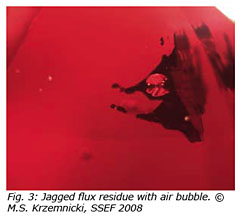
2. Magnetic Properties: Natural and Synthetic Spinels can be separated based on their different magnetic properties. A Natural Spinel has iron content hence; they show weak to moderate responses to magnets. While Synthetic Spinels have no iron content in them as a result, they do not any respond to magnets. Some light-colored and orange color of Natural Spinels is colored due to chromium, which causes it to be repelled by a magnet.
3. Refractive Index and Specific Gravity: The Natural Spinel has a Refractive Index of 1.72, in the case of Red Spinel it is 1.74 and in Zinc-rich Spinel it can be1.805 (rare to be found). Synthetic Spinels has a noticeably different R.I. of 1.727-+0.001. The specific gravity of Natural Spinels has S.G. ranges 3.58-3.61, Zinc rich Spinels have S.G. as high as 4.40. Synthetic Spinels has S.G. ranges between 3.63- 3.64.
4. Fluorescence under UV rays: A Natural Spinel has the strongest fluorescence under a long wavelength and weak to absent under a short wavelength. While, Synthetic Spinels have strong fluorescence under a short wavelength and may often a bright blue, chalky green, or red fluorescence.
Synthetic Spinel showing a neon red color under short UV rays. Picture Courtesy- Ruby Sapphire.com
5. Price: There is a big difference between the price of Natural and Synthetic Spinels. A Natural Red Spinels range starts from 100$/carat and goes till 5, ooo$/carat. Price varies from color to color; red is the costliest, followed by blue, then pink, and in the last multi-colors. Synthetic Spinels are very cheap. They are easily available in the market at a price of 1$/carat-2$per carat.
6. Synthetic dark Red Spinel is apparently not manufactured in the quantities that most of the colors. Most dark synthetic red stones are corundum.
Conclusion:
| S.No. | Basis | Natural Spinels | Synthetic Spinels |
| 1. | Price | 100$/carat-5000$/carat | 1$/carat-2$/carat |
| 2. | Natural Inclusions | Yes | No, growth signs can be seen |
| 3. | Strongest Fluorescence | Under long wavelength | Under short wavelength |
| 4. | Refractive Index | 1.72 | |
| 5. | Specific Gravity | 3.58-3.61 | 3.63-3.64 |
| 6. | Response to Magnet | Yes | No |
| 7. | The ratio of Al: Mg | 1:1 | 2:1 under flame fusion method |
In case you would like to discuss anything about spinels and wholesale spinels, do not hesitate to send an email directly to Navneet at navneet@navneetgems.com. Also, Check out our active social media: Instagram.
